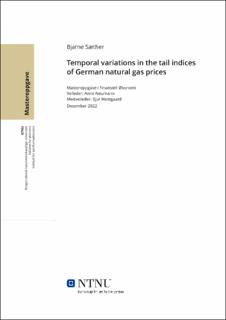| dc.contributor.advisor | Neumann, Anne | |
| dc.contributor.advisor | Westgaard, Sjur | |
| dc.contributor.author | Sæther, Bjarne | |
| dc.date.accessioned | 2023-01-11T18:19:30Z | |
| dc.date.available | 2023-01-11T18:19:30Z | |
| dc.date.issued | 2022 | |
| dc.identifier | no.ntnu:inspera:128392874:34108539 | |
| dc.identifier.uri | https://hdl.handle.net/11250/3042809 | |
| dc.description.abstract | Naturgass er en viktig innsatsfaktor for oppvarming og elektrisitetsproduksjon i Tyskland. I de senere årene har prisene på naturgass steget mye og volatiliteten har økt. Kombinasjonen av lavere hjemlig naturgassproduksjon i Europa og konkurranse om flytende naturgass i det globale markedet har gjort Europa sårbart for bortfall av naturgassleveranser.
Haleindeksestimatoren er et mål for hale-fethet i statistiske fordelinger og gir en indikasjon for sannsynligheten for ekstreme priser. Vi bruker haleindeksestimatoren til å studere utviklingen av risikoen for ekstreme priser i det tyske naturgassmarkedet over tid.
Vi viser at mellom 2012 og 2022 så har sannsynligheten for ekstremt høye priser i det tyske naturgassmarkedet økt betydelig. Tilsvarende viser vi at sannsynligheten for ekstremt lave priser øker, men i mindre grad. Vi tester disse effektene for tilsvarende temperaturbetingelser i de tyske vintermånedene og vi tester om introduksjonen av fornybar energiproduksjon i det tyske elektrisitetsmarkedet gir en effekt på prisfordelingen til naturgassprisene i Tyskland. Vi viser at for tilsvarende temperaturbetingelser så øker sannsynligheten for ekstreme priser over tid. Vi viser også at nivået av fornybar energi i det tyske elektrisitetsmarkedet bidrar til mer ekstreme priser i det tyske naturgassmarkedet.
Den økte sannsynligheten for ekstreme priser i det tyske naturgassmarkedet impliserer at naturgass-systemet i Tyskland i økende grad sliter med balansen mellom tilbud og etterspørsel av naturgass. Våre funn viser at det tyske naturgass-systemet har blitt mer sårbart over tid | |
| dc.description.abstract | Natural gas is an important energy input for heating and electricity production in Germany. In recent years natural gas prices have soared and volatility has increased. The combination of lower domestic natural gas production in Europe and competition for liquefied natural gas in the global market has made Europe more vulnerable to a shortfall in natural gas deliveries.
The tail index estimator is a measure for tail fatness in statistical distributions and gives an indication for the probability of extreme prices. We use the tail index estimator to study the development of the risk of extreme prices in the German natural gas market over time.
We find that between 2012 and 2021 the probability of extremely high prices in the German natural gas market increases significantly. Similarly we find that the probability of extremely low prices increase, while to a lower degree. We test these effects for similar temperature conditions in the German winter months and we test if the introduction of renewable energy supply into the German electricity market has an effect in the price distribution for natural gas prices in Germany. Our results suggest that for similar temperature conditions the probability for extreme prices increase over time. We also find that the level of renewable energy supply in the German electricity market adds to explaining more extreme prices in the German natural gas market.
The increased likelihood for extreme prices in the German natural gas prices implies that the natural gas system in Germany to an increasing degree struggles to match supply and demand for natural gas. Using daily prices we provide empirical evidence suggesting that the German natural gas system has become more fragile over time. | |
| dc.language | eng | |
| dc.publisher | NTNU | |
| dc.title | Temporal variations in the tail indices of German natural gas prices | |
| dc.type | Master thesis | |
